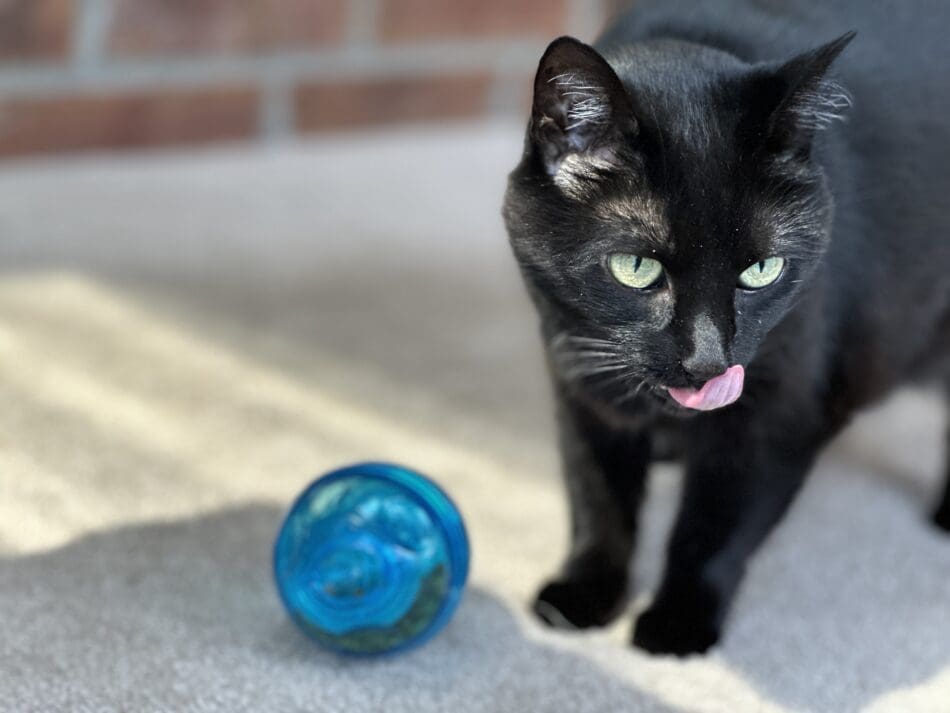
Cats do so much to make us happy and bring joy to our lives. They tolerate our erratic schedules, inconsistent training methods, miscommunications, and clumsy attempts at interpreting what they’re trying to tell us. They seem to know we love them and are doing our best to help them enjoy happy and healthy lives.
Just in case your cat care skills need a little tweaking, here’s a list of 10 things you can do to help keep your cat happy.
1. Reduce Stress Triggers
Cats are easily stressed and it can take its toll on them emotionally and physically. Stress can show up in big ways, such as when you introduce a new cat or move to a new home. It can also show up in subtle ways that are easily overlooked, such as inconsistency in a cat’s schedule or inadequate resource availability in a multicat household. Take some time to examine your cat’s environment and see what stressors could be eliminated or at least reduced. If you have a multicat household and there is some tension between a couple cats, it’s time to work on helping them find a more peaceful co-existence. That may include increasing resource availability and locations, as well as helping them begin to associate positive experiences with each other.
Some stress is unfortunately unavoidable, but there are probably multiple stress triggers in your cat’s life that don’t have to be there.
2. Create a Cat-Friendly Litter Box Set-Up
When was the last time you took a good look at whether the litter box set-up really meets your cat’s needs or not? Perhaps your cat has outgrown that tiny box you bought when she was a kitten, or maybe it’s time to add more litter boxes since you’ve increased the number of cats in your home. The litter box is an essential part of a cat’s life and if it’s dirty, too small, inconveniently located, or if it puts a cat at risk of being ambushed by other cats, then it’s time to work on improving it.
Another thing to consider is how a cat’s needs change with age. The box set-up may have served your cat well when she was young and athletic but if kitty is getting up in age and having mobility issues, it’s time to provide a litter box that’s easier to enter as well as increasing the number of boxes so she won’t have far to walk.
3. Have More Fun
Playtime is good for the body and good for the brain. Your cat needs to have fun. Conduct interactive play sessions with your cat at least twice a day. Use a fishing pole-type toy and let your cat fully enjoy what it means to be a hunter. The use of the interactive toy lets you keep a safe distance between your fingers and the cat’s teeth, and it also gives you the opportunity to move the toy like prey to motivate your cat. Playtime can be a valuable tool to help avoid behavior problems and to alleviate boredom and stress-related issues. It’s also great for reinforcing the bond between you and your cat.
Set up enrichment activities for your cat to enjoy playtime on her own as well. Don’t just pile toys up in a corner, but instead, strategically place them in locations that will spark your cat’s interest. A fuzzy mouse perched on the edge of a cat tree or peeking out from a paper bag that has been placed on its side, can be hard for a cat to resist. Puzzle feeders are another way to integrate playtime in a way cats truly understand. Place treats inside a puzzle feeder so your cat gets a reward for activity. Puzzle feeders are easily found in pet supply stores and online. You can also make homemade ones for both dry or wet food.

Photo: Pam Johnson-Bennett
Make good use of the environment to create places for your cat to climb, jump, hide, and have fun. Cat tunnels, cat trees, perches, cardboard boxes, open paper bags, etc., create added entertainment in a cat’s daily life.
4. Do a Mealtime Check-Up
How is your cat’s nutritional program? Is your cat eating food that’s appropriate for age, health, and activity level? If you have doubts, talk to your veterinarian about what might need to be changed. If your cat has gained weight, your veterinarian can make recommendations on how to set-up a weight-reduction plan that can be done safely. It’s important that cats lose weight gradually to prevent liver problems.
In addition to what your cat eats, take a look at the bowl you’re using to feed and the location of the feeding station. Cats don’t like to have their whiskers squished. The bowl you use should be shallow and wide to create whisker comfort. Place the bowl in a location that creates security and peace during mealtime.
If there’s tension in your multicat family, set up multiple feeding stations to ensure no one gets nosed out of their own food bowl.
Don’t place the water bowl right next to the food. Cats like a little distance between food and water. Keep the water bowl clean and fill it with fresh water every day. It’s a good idea to set up multiple water stations around the house to encourage your cat to stay hydrated.
5. Set up Hiding Places
Cats like to hide and the ability to do so can be a valuable stress reducer. Locate hiding places in social hubs in your house to encourage a timid or fearful cat to stay in the room. The hiding place lets the cat feel invisible and gives her time to calm down and gauge the situation. Hiding places can be created by using high-sided beds, cave-style beds, boxes on their sides, or open paper bags.
6. Increase Vertical Territory
This can be as simple as placing cat trees near windows or you can really take advantage of unused wall space and install cat shelves, cat skywalks, and wall-mounted stairways. There are many companies online that sell shelves and walkways for you to design a vertical world for your cat. The pieces must be sturdy and spaced appropriately so a cat doesn’t have to make a giant leap from one wall perch to another. It’s also important that you not create a dead end perch where a cat could be ambushed by another cat. Always have more than one on/off ramp.

Photo: Pam Johnson-Bennett
7. Be Consistent and Predictable
Cats take comfort in familiarity and having a predictable schedule. Maintain consistency in when your cat is fed, when the litter box is changed, your interaction with your cat, playtime, and so on. Understandably, changes in life happen but they can be made far less stressful if you ease your cat through them.
Be consistent in your training as well. All family members need to be on the same page so your cat doesn’t receive mixed messages.
8. Understand Your Cat’s Need to Scratch
Scratching isn’t done to be destructive and it isn’t done just to sharpen claws. A cat’s instinct to scratch serves many functions. In addition to keeping the claws healthy, scratching is used for visual and olfactory marking, stretching, and also as a way to discharge emotions. Don’t attempt to train your cat not to scratch, and certainly don’t even consider the inhumane act of declawing. Instead, provide your cat with scratching posts that meet kitty’s needs (tall, sturdy, covered in a rough material) and then place those posts in areas where your cat wants to scratch. For a cat who likes to scratch horizontally, invest in corrugated scratching pads.
Place scratching posts in socially significant areas of the home as well as at perimeters such as near entry doors.
9. Don’t Neglect Veterinary Care
Cats are very good at hiding signs of pain and illness. Don’t skip annual wellness checks, and if your cat is a senior or geriatric kitty, increase the number to twice-yearly exams.
Pay attention to changes in your cat’s behavior because that could be a red flag signifying there’s a medical problem.
If you’re reluctant to take your cat to the veterinarian because of the stress of getting her in the carrier and traveling to the clinic, take time to help your cat feel more at ease with the process. Leave the carrier out all the time and periodically place treats nearby. Work up to feeding your cat near, and eventually inside the carrier.
10. Pay Attention to What Your Cat is Saying
People end up getting scratched or bitten by cats because they often discount body language signals. Your cat is a master of communication and body language speaks volumes when it comes to whether interaction is wanted or whether she wants to be left alone. Learn more about body language and work on your approach and handling techniques so your cat will develop more trust. The more you “listen” to your cat and offer choice of whether to engage or avoid, the stronger the bond of trust will be.
Need More Information?
For more information on cat behavior and training, refer to the best-sellling books by Pam Johnson-Bennett. Pam’s books are available at bookstores and online. We’ve included Amazon links here on our website.
 Problem Solving & Advice by Pam Johnson-Bennett Cat Behavior Expert & Best-selling Author
Problem Solving & Advice by Pam Johnson-Bennett Cat Behavior Expert & Best-selling Author




